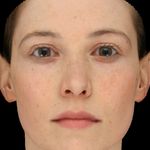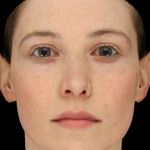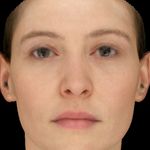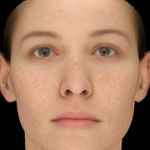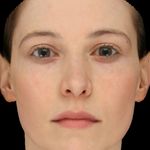A Parametric Freckle Model for Faces - gravis
←
→
Page content transcription
If your browser does not render page correctly, please read the page content below
A Parametric Freckle Model for Faces
Andreas Schneider, Bernhard Egger, Thomas Vetter
University of Basel, Switzerland
Abstract—We propose a novel stochastic generative para- parameterized by a density. Building a PCA freckle density
metric freckle model for the analysis and synthesis of human model allows us to model freckle position without leaving
faces. Morphable Models are the state-of-the-art generative the notion of point-to-point correspondence.
parametric face models. However, they are unable to synthesize
freckles which are part of natural face variation. The deficiency We evaluate the density model by comparing the proposed
lies in requiring point-to-point correspondence on the texture model to the mean density. We use specificity and general-
pixels. We propose to assume a correspondence between freckle ization as model metrics. To compute them, we introduce a
density and not the freckles themselves. We propose a model new perception-based metric for point process distributions.
that is stochastic, generative, and parametric and generates We show that the model is capable of synthesizing realistic
freckles with a point process according to a density and size
distribution. The resulting model can synthesize photo-realistic freckle patterns according to data. This is the first facial
freckles according to observations as well as add freckles freckle model.
to existing faces. We create more realistic faces than with
Morphable Models alone and allow for detailed face pigment II. P RIOR W ORK
analysis. Faces are not made out of low-frequency shape and texture
only. High-frequency details can be acquired such as in the
I. I NTRODUCTION approach of Beeler et al. [4]. With Visio-lization [5] novel
Whole industries are concerned with increasing the re- detailed faces can be synthesized in 2d by conditioning
alism of animated characters in movies, and video games. a texture synthesis algorithm on a global model trained
Artists create face rigs by tediously designing the details on pixel values of input images. Xu et al. [6] created a
necessary to create the impression of realism. We rely parametric model of different facial features in 2d including
on the face to infer different properties about a person wrinkles and spots to draw face sketches from photographs
for example age, gender, origin, social information, etc. with a hierarchical compositional model. Morphable Models
Many of these properties are environmental and reflected [7] are state of the art in parametric 3D face modeling.
in high-frequency details of the texture. Computer graphics They can be used to generate new faces according to an
models of faces should, therefore, be able to represent and underlying independent shape and texture distribution. By
express these details. In this work, we address the para- using Morphable Models Schumacher et al. [8] and Dessein
metric and generative modeling of facial freckles. Potential et al. [9] restore details from blurred or occluded images.
applications of modeling freckles are artificial aging, skin The former adds high-frequency details of Morphable Model
damage quantification [1] and face recognition [2]. The texture and the latter fits a patch-based texture model to
formation of freckles is caused by UV radiation and is deficient images. None of the methods mentioned above
influenced by genetic predisposition, and tends to increase explicitly model freckles and they do not give control over
with age. Freckle density varies on the face depending their synthesis.
on sun exposure, face geometry, and habits. Freckles are III. M ODEL
not corresponding between individuals. However, there are
We propose a parametric and generative model for freck-
regions where they are more likely to occur.
les on the face according to an empirical distribution esti-
Morphable Models[3] are only capable of modeling shape
mated on face scan textures. The core of the model consists
and texture features that correspond between subjects. Such
of a density defined on the uv map of a 3D reference mesh.
as smooth texture gradients, nasolabial folds, and lips. A
We model density, size, and freckle color independently of
freckle on one face is lacking its corresponding counterpart
each other. First, we will introduce the components of the
on another face and is therefore not captured in a Morphable
model and then show how to build it. Figure 1 gives an
Model. The underlying cause of this deficit lies in the
overview over the process. Images in the figures are viewed
assumed point-to-point correspondence.
best on a screen.
We propose a generative and parametric freckle model
which is independent of the Morphable Model but can be A. Components
combined with it. To reflect the distribution of freckles on Position and Density. We model freckle position accord-
the face, we propose to model freckles with a point process ing to a spatial Poisson point process. We model its density
parameter according to a multivariate normal distribution on
978-1-5386-2335-0/18/$31.00 c 2018 IEEEFigure 1. Overview over the proposed freckle synthesis framework. The corresponding chapters are indicate in brackets.
the surface of the shape. The spatially-varying density pa- example, be estimated from a given face or by drawing them
rameter characterizes the spatial distribution of the freckles. from the respective models.
Given a density function we can sample an infinite amount First, we draw the positions of the individual freckles from
of freckle configurations, all adhering to the given density. the spatially varying density. It contains at every pixel in the
Figure 2 shows the first principal component of the density texture the likelihood that there will be a freckle. For each
model. pixel we determine if we should place a freckle there.
Size. In contrast to the density, the freckle size distribu- Given size and color parameters of a face we select the
tion is not spatially-varying. The size of all freckles of a matching freckles from the dictionary. Per freckle position
face are determined independent of position, by the same we draw a size from the size distribution. Additionally, we
distribution. We represent the distribution with a histogram restrict the selection process to a ball around the current
and create a multivariate Gaussian model over histograms. position to remove warping effects due to the texture em-
Color. To obtain consistency between freckle color and bedding. Target freckle color is conditioned on the skin tone
skin tone we model freckle color depending on skin tone. of the face we want to add the freckle to. We add a selected
The skin tone of a given Morphable Model texture is the freckle to the texture with seamless cloning.
average texture color of the skin region. Freckle color
is the average color of all freckles on a given face. We IV. M ODEL B UILDING
model the dependency as a multivariate conditional Gaussian We estimate freckle position, size, and color as well as
distribution of the freckle color given the skin tone. skin tone from high-resolution face scans. Then, we build
Appearance. Because freckle appearance is diverse and the models for density, size, and color (see Figure 1).
a large amount of freckles are easily available, we model Data. We train the model from 22 high-quality face
appearance according to a dictionary of exemplary freckles. scans of individuals of Caucasian origin exhibiting vary-
We determine concrete freckle appearance by selecting a ing amounts and configurations of freckles. The scans
freckle from a dictionary according to the parameters size, are acquired in a controlled setting and illuminated with
color, and position on the original texture. The freckles are an uniform light source, the same way the Basel Face
seamlessly cloned into the texture with Poisson image edit- Model[11] data was acquired. Density. We estimate freckle
ing [10]. The target texture should be ambient for example density of a given texture by detecting and segmenting
a Morphable Model texture. them. We manually annotate freckles in training textures
and classify the pixels into freckle and non-freckle. With
B. Synthesis the interactive pixel classification tool Ilastik [12] we create
We generate freckles according to a given density, size a probability map. We segment the freckles by thresholding.
distribution, and color parameter. These parameters can, for Each segment is assumed to be a freckle. We determine theposition by computing the barycenter per segment. The next impose the maximal distance. This measure, however, does
step is to turn the positions into a density. Density d on the not consider where unassigned points lie. Having points in
surface x is a linear combination of Gauss kernels with a a very sparse region should be penalized more than in a
specified fall off σ: high-density region.
X To ameliorate this, we propose the following modifica-
d(x) = N (c − x, σ) (1) tions to the measure such that we account for the difference
c∈centers
in density between the two sets. For an unassigned point xi
We choose the fall off σ such that there is an overlap in a set ξ we impose the distance to the nearest neighbor
between densities of different faces (≈ 0.7cm). The result (nn) in the set η and weight it by the difference between
is a spatially-varying density function per scan texture from the number of points in the -Ball around xi in ξ and η:
which we build a PCA model. X
Size. The size of a freckle is the radius in pixels U (ξ, η) = d0 (xi , nn(xi , η)) |ρ (xi , ξ) − ρ (xi , η)|
p of a circle
that covers the same area as the freckle (r = Afreckle /π). x∈unassigned
(2)
We create a histogram over all the freckle sizes of the whole
This measure is small if unassigned points are close to points
face.
in the other set and distributed such that they do not change
Color Freckle color is the average color over the area
the density much.
covered by the freckle. The freckle color of a face is the
average color over all freckles. The skin tone is the average VI. E XPERIMENTS
color of the skin region of the face. A. Quantitative Evaluation
V. M ODEL S ELECTION We measure generalization and specificity of different
We compare different freckle models by computing model variants of the proposed model. We compare it to a baseline
specificity and generalization. Both measures build on a model. It generates points according to the mean density
distance measure between samples. In our case, a measure of the training population. We compute Generalization on
between two freckle configurations is required. a test set of 15 examples. We generate 1000 samples from
the freckle model to calculate specificity. Table I shows the
A. Model Measure results for the two models. Also we found that reducing the
We evaluate the models by computing generalization to rank of the model does not lead to an improved model.
unseen data and specificity of generated samples to a test
Model Specificity Generalization Total
set [13]. baseline model 110 269 379
1) Generalization: Generalization measures how the proposed 149 143 292
model can represent faithful samples from the original Table I
distribution. We build a single model on the training set and Specificity and generalization for the proposed model and the mean
validate it on a separated test set. We compute the distance density model. Units are density weighted distances (Equation 2). The
full density model leads to a better trade-off (total is sum of both)
between a sample from the test set and its closest neighbor between specificity and generalization than the mean.
in model space.
2) Specificity: Specificity measures how close samples
from the model are to the real distribution. We compute
B. Perceptual Evaluation of Point Distribution Measure
the distance between model samples and the sample closest
from the test set. There are many different ways of measuring the distance
between two point clouds, but not all of them are similar to
B. Point Process Distribution Measure perception. In the following we aim to find out whether the
To judge whether two sets of points are similar, and measure is similar to human perception. We show different
to be able to compute specificity and generalization, we point patterns to 5 people and ask them to compare how
introduce a new metric on point process distributions. First, similar they are to each other. We show them two images,
we explain shortly the metric introduced by Schuhmacher and they have to determine to which of the two a third
and Xia [14], which compares two point sets ξ and η by image is more similar to. We apply the measure to the
assigning points between them. It consists of two terms, same task. The images contain randomly generated point
one measures how well assigned points match and the patterns with at least 10 and up to 30 spots. Then we count
other, U , penalizes unassigned points. Their metric finds the number cases where the measure agrees with the choice
the assignment between two sets of points such that the of the participants. We observe an agreement of 74%. The
sum of the distances between assigned points is minimal. probability to obtain this result or a better one by chance is
To measure the matching, we find the assignment from all p = 0.02. Therefore, the measure is better than chance to
possible assignments, that minimizes the Euclidean distance predict how two point patterns will be perceived as similar.
between the all pairs of assigned points. Points not assigned Figure 4 shows an example question.Figure 2. Visualization of the parametric components of our freckle model (along first principal component).
(a) (b) (c) (d) (e) (f) (g)
Figure 3. Face analysis: We estimate freckle model parameters from an input face and draw samples from it. From left to right: a) Input face b) estimated
density c) freckles drawn from the model at the estimated parameter on an average face d) Scan with freckles removed e) and f) novel freckles synthesized
on cleared skin from d) g) projection of input texture into Morphable Model space (PCA). (Details viewed best on screen or in supplementary material)
Figure 4. Example question of the perceptual experiment to measure the
quality of the point process. Participants had to determine if the pattern
in the middle is more similar to the one on the left or the right. Most
participants chose left which is consistent to our measure proposed in
Section V-B.
Figure 5. Image manipulation result: Original image and freckles added
according to the identity in Figure 3. Image is from Multi-PIE [16].
C. Model Samples
Figure 3 shows an example face scan projected into the
freckle model, the extracted density, freckles removed from Model texture and add the difference between the freckled
the scan, and samples drawn from the model at the projected and unfreckled texture to the image (Figure 5).
coefficients. VII. C ONCLUSION
D. Freckle Removal We presented a stochastic and parametric model for freck-
We use the freckle detections to determine freckled and les. We model freckle density, size and color parametrically
non-freckled regions. To remove them, we fill the detected and appearance empirically. The proposed model is capable
freckles with push-pull interpolation [15] (See Figure 3). of generating photo-realistic freckles according to the data.
Freckles are synthesized according to a spatially-varying
E. Image Manipulation density to respect different facial regions. We proposed
The freckle model lends itself for image manipulation. We a metric to compare point clouds and found the metric
synthesize freckles according to the model and add them to to be consistent with perception. We evaluate the model
an image. We fit Morphable Model parameters to the input qualitatively and quantitatively and apply it to an image
image with the approach of Schönborn et al. [17] resulting in manipulation task.
an illumination free texture. We synthesize on the MorphableR EFERENCES [14] D. Schuhmacher and A. Xia, “A new metric between distri-
butions of point processes,” Advances in applied probability,
[1] R. G. Gamble, N. L. Asdigian, J. Aalborg, V. Gonzalez, vol. 40, no. 3, pp. 651–672, 2008.
N. F. Box, L. S. Huff, A. E. Barón, J. G. Morelli, S. T.
Mokrohisky, L. A. Crane et al., “Sun damage in ultraviolet [15] S. J. Gortler, R. Grzeszczuk, R. Szeliski, and M. F. Cohen,
photographs correlates with phenotypic melanoma risk factors “The lumigraph,” in Proceedings of the 23rd annual con-
in 12-year-old children,” Journal of the American Academy ference on Computer graphics and interactive techniques.
of Dermatology, vol. 67, no. 4, pp. 587–597, 2012. ACM, 1996, pp. 43–54.
[2] J.-S. Pierrard and T. Vetter, “Skin detail analysis for face [16] R. Gross, I. Matthews, J. Cohn, T. Kanade, and S. Baker,
recognition,” in Computer Vision and Pattern Recognition, “Multi-pie,” Image and Vision Computing, vol. 28, no. 5, pp.
2007. CVPR’07. IEEE Conference on. IEEE, 2007, pp. 1–8. 807–813, 2010.
[3] V. Blanz and T. Vetter, “A morphable model for the synthesis [17] S. Schönborn, B. Egger, A. Morel-Forster, and T. Vetter,
of 3d faces,” in Proceedings of the 26th annual conference “Markov chain monte carlo for automated face image analy-
on Computer graphics and interactive techniques. ACM sis,” in International Journal of Computer Vision. Springer,
Press/Addison-Wesley Publishing Co., 1999, pp. 187–194. 2016.
[4] T. Beeler, B. Bickel, P. Beardsley, B. Sumner, and M. Gross,
“High-quality single-shot capture of facial geometry,” in ACM
Transactions on Graphics (TOG), vol. 29, no. 4. ACM, 2010,
p. 40.
[5] U. Mohammed, S. J. Prince, and J. Kautz, “Visio-lization:
generating novel facial images,” ACM Transactions on Graph-
ics (TOG), vol. 28, no. 3, p. 57, 2009.
[6] Z. Xu, H. Chen, S.-C. Zhu, and J. Luo, “A hierarchical com-
positional model for face representation and sketching,” IEEE
Transactions on Pattern Analysis and Machine Intelligence,
vol. 30, no. 6, pp. 955–969, 2008.
[7] P. Paysan, R. Knothe, B. Amberg, S. Romdhani, and T. Vetter,
“A 3d face model for pose and illumination invariant face
recognition,” in Proceedings of the 6th IEEE International
Conference on Advanced Video and Signal based Surveillance
(AVSS). IEEE, 2009, pp. 296–301.
[8] M. Schumacher, M. Piotraschke, and V. Blanz, “Hallucination
of facial details from degraded images using 3d face models,”
Image and Vision Computing, vol. 40, pp. 49 – 64, 2015.
[9] A. Dessein, W. A. Smith, R. C. Wilson, and E. R. Hancock,
“Example-based modeling of facial texture from deficient
data,” in Proceedings of the IEEE International Conference
on Computer Vision, 2015, pp. 3898–3906.
[10] P. Pérez, M. Gangnet, and A. Blake, “Poisson image editing,”
in ACM Transactions on graphics (TOG), vol. 22, no. 3.
ACM, 2003, pp. 313–318.
[11] A 3D Face Model for Pose and Illumination Invariant Face
Recognition. Genova, Italy: IEEE, 2009.
[12] C. Sommer, C. Straehle, U. Koethe, and F. A. Hamprecht,
“Ilastik: Interactive learning and segmentation toolkit,” in
Biomedical Imaging: From Nano to Macro, 2011 IEEE In-
ternational Symposium on. IEEE, 2011, pp. 230–233.
[13] M. Styner, K. T. Rajamani, L.-P. Nolte, G. Zsemlye,
G. Székely, C. J. Taylor, and R. H. Davies, “Evaluation of
3d correspondence methods for model building,” in IPMI,
vol. 3. Springer, 2003, pp. 63–75.You can also read





